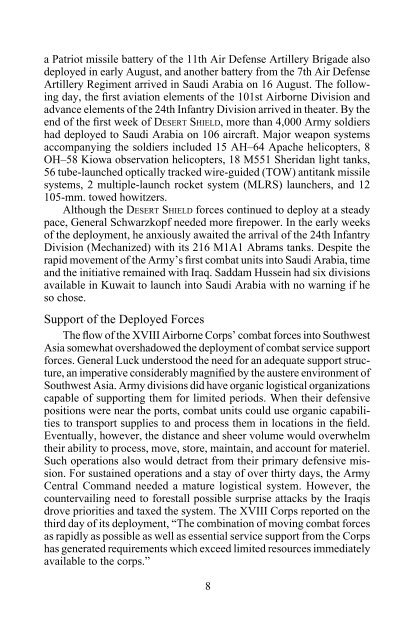You also want an ePaper? Increase the reach of your titles
YUMPU automatically turns print PDFs into web optimized ePapers that Google loves.
a Patriot missile battery of the 11th Air Defense Artillery Brigade alsodeployed in early August, and another battery from the 7th Air DefenseArtillery Regiment arrived in Saudi Arabia on 16 August. The followingday, the first aviation elements of the 101st Airborne Division andadvance elements of the 24th Infantry Division arrived in theater. By theend of the first week of Desert Shield, more than 4,000 Army soldiershad deployed to Saudi Arabia on 106 aircraft. Major weapon systemsaccompanying the soldiers included 15 AH–64 Apache helicopters, 8OH–58 Kiowa observation helicopters, 18 M551 Sheridan light tanks,56 tube-launched optically tracked wire-guided (TOW) antitank missilesystems, 2 multiple-launch rocket system (MLRS) launchers, and 12105-mm. towed howitzers.Although the Desert Shield forces continued to deploy at a steadypace, General Schwarzkopf needed more firepower. In the early weeksof the deployment, he anxiously awaited the arrival of the 24th InfantryDivision (Mechanized) with its 216 M1A1 Abrams tanks. Despite therapid movement of the Army’s first combat units into Saudi Arabia, timeand the initiative remained with Iraq. Saddam Hussein had six divisionsavailable in Kuwait to launch into Saudi Arabia with no warning if heso chose.Support of the Deployed ForcesThe flow of the XVIII Airborne Corps’ combat forces into SouthwestAsia somewhat overshadowed the deployment of combat service supportforces. General Luck understood the need for an adequate support structure,an imperative considerably magnified by the austere environment ofSouthwest Asia. Army divisions did have organic logistical organizationscapable of supporting them for limited periods. When their defensivepositions were near the ports, combat units could use organic capabilitiesto transport supplies to and process them in locations in the field.Eventually, however, the distance and sheer volume would overwhelmtheir ability to process, move, store, maintain, and account for materiel.Such operations also would detract from their primary defensive mission.For sustained operations and a stay of over thirty days, the ArmyCentral Command needed a mature logistical system. However, thecountervailing need to forestall possible surprise attacks by the Iraqisdrove priorities and taxed the system. The XVIII Corps reported on thethird day of its deployment, “The combination of moving combat forcesas rapidly as possible as well as essential service support from the Corpshas generated requirements which exceed limited resources immediatelyavailable to the corps.”8












